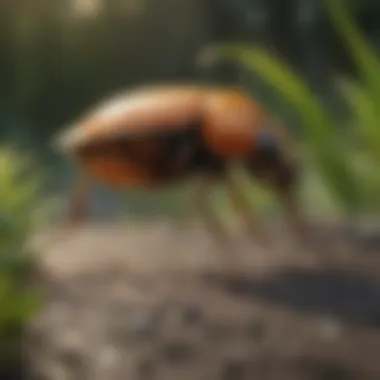Effective Natural Pest Control Strategies for San Diego


Intro
Natural pest control is increasingly gaining traction as homeowners look for effective ways to manage common pests without relying solely on chemical treatments. In San Diego, where the climate and ecosystem favor a diverse array of insects and rodents, adopting eco-friendly solutions is not just a choice but a necessity for many.
Understanding the unique local pest landscape is essential for successful pest management. This guide aims to equip homeowners with knowledge about prevalent pests, effective prevention strategies, and treatment options that align with environmentally sound practices. By integrating these methods into daily routines, individuals can contribute to a healthier living environment while ensuring their homes remain pest-free.
Pest Identification
Identifying common pests in the San Diego area is the first step towards effective pest control. This not only helps in deciding the appropriate strategies but also enhances awareness of pest behavior.
Detailed descriptions of common pests
- Ants: Ants are social insects often seen in kitchens and along trails. Common species include the Argentine ant and the carpenter ant. They are not just a nuisance but can damage wood structures.
- Cockroaches: Roaches thrive in warm climates and are commonly found in homes. The American roach and the German roach are prevalent in urban areas. They can trigger allergies and signify unsanitary conditions.
- Rodents: Mice and rats are frequent visitors in homes. They can cause structural damage and contaminate food.
- Termites: Known for their damaging appetite, termites can destroy wooden foundations leading to significant repair costs if left unchecked.
Signs and symptoms of infestations
- Ants: Look for small piles of debris, typically excrement or nesting materials.
- Cockroaches: Presence of dark, oval droppings or empty egg cases around food sources.
- Rodents: Scratching noises at night, greasy smudge marks on walls, and droppings in cupboards.
- Termites: Hollow-sounding wood or discarded wings around the home.
"A proactive approach to pest identification can save homeowners from costly repairs and health issues."
Prevention Strategies
Preventing pest infestations is often easier than eliminating them once they have established a presence in a home. Simple maintenance practices combined with natural deterrents can significantly reduce the likelihood of pest problems.
Home maintenance tips for pest prevention
- Seal cracks and gaps around windows, doors, and foundations to limit entry points.
- Keep food stored in airtight containers to minimize attraction.
- Regularly clean under appliances and furniture where crumbs often accumulate.
- Trim vegetation away from the home to reduce hiding spots for pests.
Natural deterrents and barriers
Homeowners can utilize several natural methods to deter pests. Some effective options include:
- Diatomaceous Earth: This natural powder can be spread in areas where pests roam; its abrasive nature damages the pest's exoskeleton.
- Essential Oils: Oils like peppermint and tea tree can repel ants and roaches when diluted and sprayed around entry points.
- Soap Solutions: A simple mixture of water and soap can suffocate insects when applied directly.
Treatment Options
When pests become a problem, homeowners often consider treatment options. Understanding the difference between chemical and natural treatments is crucial.
Overview of chemical vs. natural treatments
Chemical treatments may provide quick results but often carry risks to health and the environment. Alternatively, natural treatments can be safer but may require consistent application for long-term effectiveness. Both methods can be used in conjunction for optimal results.
Step-by-step guides for DIY treatments
- For Ants: Mix equal parts sugar and borax. Place the bait in shallow dishes where ants are seen.
- For Cockroaches: Create a paste using baking soda and sugar. Leave it in areas where roaches frequent.
- For Rodents: Set traps securely to avoid accidental capture of pets or wildlife.
- For Termites: Use nematodes in soil around the home to naturally combat these pests.
By implementing proper pest identification, prevention strategies, and treatment options, homeowners in San Diego can achieve a sustainable approach to pest management. Engaging with these natural methods fosters a healthier environment for families and the community, ensuring that urban living can coexist with nature.
Prelims to Natural Pest Control
Natural pest control is an essential approach for managing pests while minimizing harm to the environment. In San Diego, where urbanization coexists closely with nature, this method is especially relevant. Homeowners often seek effective solutions that do not require harmful chemicals. Understanding how to use natural pest control methods can lead to healthier living spaces and sustainable practices.
Definition and Importance


Natural pest control refers to methods and practices that aim to manage pest populations through non-toxic means. This includes the use of biological controls, habitat manipulation, and physical barriers, rather than conventional chemical pesticides. The significance of natural pest control lies in its ability to protect both the ecosystem and human health. By integrating these methods, individuals can reduce chemical exposure, preserve beneficial insects, and promote biodiversity. Moreover, as awareness of environmental issues increases, natural pest control becomes a more acceptable and sought-after solution among concerned homeowners.
Overview of Pest Issues in San Diego
San Diego's unique climate fosters a variety of pests that can become nuisances in residential properties. Common pests include ants, termites, cockroaches, and rodents. Each pest presents specific challenges due to their varying life cycles and behaviors. Understanding these pest issues is crucial for effective management.
- Ants: Known for their ability to invade homes in search of food, ants are often seen during warmer months. Their colonies can grow rapidly, triggering infestations that are difficult to control.
- Termites: These wood-destroying insects pose significant risks to properties. San Diego's warm temperatures can result in year-round activity, which increases the chance of structural damage.
- Cockroaches: Typically associated with unclean environments, cockroaches are resilient and can reproduce quickly, making them hard to eradicate.
- Rodents: Mice and rats not only contaminate food sources but can also damage electrical wiring and structures. They are particularly adept at finding their way into homes.
Awareness of these specific pest issues allows homeowners to take proactive steps in implementing natural pest control solutions that are tailored to the local environment. The integrated approach to managing these pests is paramount for maintaining a healthy and sustainable living space.
Common Pests in San Diego
Understanding the common pests in San Diego is fundamental for effective natural pest control. This region's unique climate and geography create a specific environment that supports a variety of pests. Homeowners need to be aware of these organisms, as their presence can lead to significant issues, ranging from minor annoyances to serious health risks. This knowledge enables homeowners to take proactive measures in pest management, leading to a more harmonious living space and an overall improved quality of life.
Identification of Local Pests
Identifying local pests is the first step in controlling them. In San Diego, homeowners often encounter several common pests:
- Ants: Species like the Argentine and pavement ants invade homes, seeking food and water. They can form large colonies and become persistent nuisances.
- Cockroaches: The German and American cockroaches are prevalent. They thrive in warm, humid conditions and are known to carry allergens and pathogens.
- Termites: Drywood and subterranean termites can cause extensive damage to wooden structures if not identified early.
- Spiders: Common species include the black widow and brown recluse. While most spiders are harmless, their bites can result in medical emergencies.
- Rodents: Mice and rats are frequently found near homes. They are not only a nuisance but also pose health hazards due to potential disease transmission.
Effective pest identification allows for targeted control methods. It also helps in avoiding unnecessary pesticide use, promoting a more natural approach to pest management.
Life Cycles and Behavior
Understanding the life cycles and behaviors of local pests is essential for developing effective control strategies. For instance, ants have a colony structure where the queen lays eggs. These eggs hatch and progress through larval and pupal stages before becoming adult ants. This cycle can repeat rapidly, resulting in large infestations if left unmanaged.
Cockroaches, on the other hand, reproduce quickly, with a single female capable of producing hundreds of offspring in her lifetime. Awareness of their habits can inform strategies like sealing food sources and maintaining cleanliness, which are vital for preventing an infestation.
Termites also exhibit interesting behaviors. They are social insects that share food and care for their young within a colony. Understanding their feeding habits can help in creating barriers to protect homes from damage.
Principles of Natural Pest Control
Natural pest control methods are essential in creating a sustainable environment, especially in urban settings like San Diego. The core principles focus on understanding and utilizing the natural behaviors of pests and their predators. These principles aim to establish a balance that minimizes pest populations without relying solely on chemicals. This is crucial not only for maintaining a healthy ecosystem but also for ensuring the safety of humans and pets. By adopting these principles, residents can foster a healthier living environment and mitigate pest issues effectively.
Cultural Control Strategies
Cultural control encompasses practices that modify the environment to make it less conducive to pests. This includes proper waste management, which can significantly reduce the food sources for pests. Keeping gardens tidy by removing debris and using mulch can also deter pests like snails and slugs. Additionally, planting pest-resistant varieties of plants can greatly limit the opportunities for pests to thrive.
Moreover, regular monitoring and maintaining healthy soil contribute to strong plants. Strong plants are less vulnerable to pest attacks, reducing the need for interventions. Homeowners can create a robust gardening schedule, emphasizing good cultural practices, such as crop rotation, which can disrupt pest life cycles and minimize infestations.
Biological Control Agents
Biological control agents involve the use of natural enemies to manage pest populations. These may include insects like ladybugs, which consume aphids, or parasitic wasps, which target caterpillar pests. By introducing these beneficial organisms, homeowners can naturally reduce pest numbers without chemical interventions. This method highlights the importance of biodiversity within gardens, allowing beneficial insects to thrive.
To implement biological control, homeowners should consider the existing ecosystem. It is crucial to avoid introducing non-native species, as they can disrupt local flora and fauna. Instead, focus on encouraging existing beneficial insects by providing habitats, such as insect hotels or native plants that attract them. This can create a balanced environment where natural pest control methods flourish.
Physical Barriers and Traps
Physical barriers and traps are direct methods used to prevent pests from invading a property. Common strategies include using row covers in gardens to protect plants from insects and installing screens on windows and doors to keep pests outside. Traps can be effective for specific pests, such as sticky traps for flying insects or bait traps for rodents. These methods not only reduce pest populations but also minimize the need for chemical treatments, aligning with sustainable practices.
When considering physical barriers, making them effective is key. For example, ensure that gaps and entry points around the home are sealed. Regular inspections can help identify potential vulnerabilities. Setting traps should also be part of a routine maintenance plan. This will ensure that any issues are caught early, protecting the home from infestations.
By combining cultural, biological, and physical pest control strategies, homeowners can create a comprehensive approach to managing pests naturally. This method is not only effective but also aligns with environmentally friendly practices.


Environmental Considerations
Natural pest control is not just about resolving a pest issue; it is also about fostering a sustainable relationship with the environment. This section emphasizes how environmental considerations underpin effective pest management strategies in San Diego. Understanding the connections between pests, plants, and local ecosystems is crucial for homeowners aiming for lasting solutions.
Sustainability and Ecological Balance
Sustainability and ecological balance are cornerstones of natural pest control. In San Diego, where urbanization and biodiversity coexist, practicing sustainable methods can lead to healthier ecosystems. Homeowners need to recognize that every action taken can have a ripple effect in nature.
- Resource Conservation: Utilizing natural methods often requires fewer chemical inputs and conserves resources. By reducing reliance on synthetic pesticides, homeowners can protect beneficial organisms and preserve water quality.
- Soil Health: Healthy soil promotes plant growth and resilience against pests. Practices such as crop rotation, cover cropping, and composting enhance soil quality, which in turn fosters a balanced ecosystem.
- Wildlife Support: Creating a balanced environment allows for the support of beneficial wildlife such as birds and predatory insects. These species naturally control pest populations, creating a self-regulating ecosystem.
Through these processes, homeowners not only manage pests effectively but also contribute to an eco-friendly lifestyle. Enhancing ecological balance results in a more sustainable home environment.
Impact on Non-target Species
Whenever pest control methods are implemented, consideration for non-target species is vital. In San Diego, the local fauna includes countless beneficial insects and wildlife that play important roles in the ecosystem.
- Minimizing Harm: Natural pest control methods tend to be less harmful than traditional chemical approaches. However, it is still crucial to evaluate impacts carefully. Strong methods like neem oil or diatomaceous earth, for example, can affect beneficial organisms if misused.
- Understanding Interactions: An awareness of the interplay between different species can help mitigate unintended consequences. For instance, providing habitats for ladybugs will ensure they are available for aphid control, thus preventing the need for more aggressive pest interventions.
- Long-term Health of Ecosystem: Resilient ecosystems thrive on diversity. Ensuring that pest control methods do not negatively impact non-target species helps maintain this necessary diversity, ultimately leading to a healthier environment.
"Conservation and pest control are not mutually exclusive. The right practices ensure both can coexist harmoniously."
In summary, the environmental considerations of natural pest control extend beyond simple pest management. They encompass sustainability, ecological balance, and the well-being of non-target species. By being mindful of these factors, homeowners can achieve effective pest control while respecting and nurturing the natural world around them.
Practical Implementation of Natural Methods
Implementing natural pest control methods is crucial for homeowners in San Diego. The increasing awareness of eco-friendly solutions has highlighted the need for practical approaches that not only manage pests effectively but also protect the environment. Determining the right practices can help maintain health in local ecosystems and promote better living conditions.
Natural pest control reduces reliance on harsh chemicals, often used in conventional pest management. Such substances can pose risks not only to humans and pets but also to other wildlife and plants in the area. Understanding these methods allows homeowners to make informed choices.
Developing an Integrated Pest Management Plan
An integrated pest management plan, or IPM plan, is a strategic approach combining various methods to control pest populations while minimizing harm to the environment. Creating an effective IPM plan involves several steps:
- Assessment of Pest Problems: Begin by identifying the specific pests affecting your home or garden. Look for signs of damage or infestation, such as holes in plants or unusual droppings.
- Monitoring: Regular observations are critical. Keeping a log of pest activity helps understand the patterns, which can influence your control measures.
- Control Options: Choose from a range of control methods. Integrated pest control may include cultural practices, biological control, and physical barriers. Always consider the non-target species to maintain ecological balance.
- Evaluation: After implementing control measures, assess their effectiveness. Adjust your plan based on observed results and make improvements as needed.
"Integrated pest management is an essential framework for balancing pest control with ecological considerations."
DIY Solutions for Homeowners
Many homeowners prefer do-it-yourself solutions for pest control because they are often cost-effective and accessible. Simple strategies include:
- Natural Repellents: Using garlic, vinegar, or essential oils can deter pests without harming beneficial insects.
- Trap Construction: Homemade traps can effectively monitor and capture pests. For example, placing a soapy water dish under lights can attract and trap insects.
- Companion Planting: Planting certain species together, like marigolds with vegetables, can naturally repel pests while providing benefits to both plants.
These DIY practices can empower homeowners, making them feel more connected to their environment and equipped for pest management.
Professional Services for Natural Pest Control
Sometimes, the pest problem may escalate beyond what DIY measures can handle effectively. In such cases, professional services become necessary. Seek out companies that specialize in natural pest control. Ensure they employ environmentally friendly methods that are safe for both your family and non-target species. Look for the following qualities in a service provider:
- Certifications: Verified credentials indicate that the technician is knowledgeable in natural pest control.
- Reputation: Customer reviews can help gauge the effectiveness of their strategies. Check platforms such as Facebook and Reddit for insights.
- Warranty: A service provider that offers follow-up services or a satisfaction guarantee shows confidence in their methods.
In the evolving landscape of pest management, practical implementation is integral to ensuring both effectiveness and sustainability in San Diego's unique environment.
Challenges and Limitations


Natural pest control presents various advantages, yet it also faces distinct challenges that warrant careful consideration. Understanding these limitations can help individuals make informed decisions on integrating natural methods into their pest management strategies. The objective is to provide insights into these challenges, which ultimately guides homeowners in San Diego to manage pests effectively without relying solely on synthetic chemicals.
Effectiveness versus Conventional Methods
One primary concern with natural pest control is its effectiveness compared to conventional methods. Traditional pest control often utilizes synthetic chemical pesticides. These products tend to provide immediate results against infestations. In contrast, natural solutions may bring slower results. For instance, utilizing beneficial insects such as ladybugs can take longer to significantly reduce pest populations. While these methods are effective, they may require more time and patience.
Natural pesticides, derived from plants or beneficial organisms, may not consistently match the strength of their synthetic counterparts. This raises questions for homeowners who might see their pest problems worsening during initial treatment phases. It is crucial to manage expectations when relying on natural methods. Building an understanding of how these methods work might help prevent discouragement. The longer-term environmental and health benefits often outweigh these initial struggles, encouraging a more sustainable approach.
Seasonal Variations and Pest Activity
Another factor affecting the implementation of natural pest control is seasonal variations. San Diego's climate allows for a unique pest activity pattern that homeowners need to understand. Different pests peak at various times of the year. For example, ants often invade homes during warm months in search of food, while other pests, like cockroaches, may seek shelter indoors during colder periods.
This seasonal behavior impacts the success of natural pest control methods. During peak infestations, conventional methods might seem more effective due to their immediate results. However, understanding these cycles can enhance the effectiveness of natural remedies. Homeowners might find certain natural controls work better in specific months. For example, neem oil is commonly used for many pests but might be less effective during peak summer months when pests are more resilient.
"Understanding pest behavior throughout the year is crucial in planning effective natural pest control strategies."
Monitoring the seasons and aligning pest control measures accordingly can increase success rates. Homeowners can react proactively by employing natural methods that are best suited for particular pests during their active periods. Facing these seasonal challenges with knowledge can lead to more fruitful outcomes in pest management.
Future Trends in Natural Pest Control
As we look towards the future of natural pest control, several trends are emerging that hold significant promise for homeowners and pest management professionals in San Diego. Understanding these trends is important for improving effectiveness, efficiency, and ecological sustainability in pest control practices.
Research and Development in Pest Management
Research plays a vital role in advancing natural pest control methods. Scientists are continually exploring the dynamics of pest populations, their interactions with natural predators, and the ecological impact of various control strategies. Developments in fields such as entomology and ecology are leading to more targeted pest management solutions.
One area of focus is the study of pest behavior and life cycles. By understanding how pests reproduce and survive, researchers can develop more effective biological control methods. For example, researchers are investigating ways to enhance the efficacy of beneficial insects, such as ladybugs or parasitic wasps, which can naturally suppress pest populations. This includes looking into the optimal conditions for their release and the potential for breeding programs.
Additionally, integrating pest management strategies is gaining traction. This involves combining different methods, such as biological and physical controls, to achieve better results. Research in San Diego is looking at unique local pests and finding specific natural predators that work best in those environments.
Technological Innovations and Applications
Technological innovations are reshaping the landscape of pest control. New tools and methodologies are becoming available that make natural pest control more accessible and user-friendly.
For instance, smart traps that use sensors and alerts can be particularly beneficial for homeowners. These traps identify the presence of specific pests and notify users in real-time, allowing for timely intervention when pest populations become problematic. This proactive approach minimizes the need for chemical interventions.
Moreover, advancements in tracking and monitoring pest populations through mobile applications are helping homeowners actively engage in pest management. These apps often provide information on local pests, offering guidance on identification and effective natural remedies.
"Integrating technology with sustainable practices can significantly reduce the reliance on harmful chemicals while being effective."
Another noteworthy trend is the use of drones for monitoring pest infestations in larger agricultural areas. Drones equipped with imaging technology can provide data on pest distribution and areas of concern, allowing for targeted interventions. This strategy not only reduces chemical use but also leverages precision agriculture techniques to ensure better crop health.
In San Diego, these trends indicate a shift towards more sustainable practices that prioritize natural methods, emphasizing the balance between effective pest management and ecological preservation. As these advancements continue to develop, homeowners and pest control professionals can look forward to more innovative and environmentally friendly solutions.
Epilogue and Summary
The significance of using natural pest control is underscored by considerations such as environmental impact and human health. One of the main benefits is the reduction of chemical exposure for families and pets, making natural methods a wiser choice in dense residential areas. Furthermore, recognizing and utilizing local biological control agents can greatly improve the effectiveness of pest management strategies.
Recap of Key Points
A brief summary of crucial points discussed:
- Definition and Importance: Understanding what natural pest control entails and why it matters in San Diego.
- Identification of Pests: Recognizing the specific pests predominant in San Diego and their biological traits.
- Integrated Pest Management: Developing comprehensive strategies that include various control methods, emphasizing sustainability.
- Environmental Considerations: The need to maintain ecological balance, including the impact on non-target species.
- Implementation and Practical Solutions: Exploring DIY methods for residents and the role of professional services in natural pest control.
- Future Trends: Keeping abreast of innovations and research in the field, ensuring effective and modern practices are applied.
Encouragement for Sustainable Practices
It is crucial for homeowners and housewives in San Diego to embrace sustainable pest control practices. By adopting natural methods, they not only contribute to a healthier local environment but also protect their own living spaces. Utilizing organic solutions, such as insecticidal soaps and beneficial insects, can significantly decrease reliance on synthetic pesticides.
Also, cultivating awareness and knowledge allows individuals to make informed decisions about pest management in their households. Promoting biodiversity in gardens and recognizing the role of various organisms can create a natural defense system against pests. Collaboratively, if more households in San Diego prioritize sustainable practices, the community can witness a notable improvement in urban ecological health.
Natural pest control is not just a trend, but a commitment to a safer and more sustainable environment for everyone.



